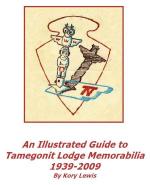It seems that since the early days of Boy Scout camps, there has been a need to recognize those campers that return for year after year. In some of the early felt camp patches there are patches that state, 1st year camper, 2nd year camper, 3rd year camper, or something similar. An alternative, and the system used for Camp Naish, is the rocker. There are five eras of rockers. The first is a chevron-type that typically goes with the Daniel Boone or Frontiersman camp patch. The chevron is a red bar that went below the camp patch. These were used from around 1941-1944.
A camper from this time period indicated that there was also a white version of this chevron that was used for a winter camping event held at Camp Naish around 1941 or 1942. Does anyone have additional information about this event?
The next type is the red and green twill variety. These were used from 1945-1950 with the early white twill versions of the Camp Naish patch.
Following that is the white and red twill variety. These were used from 1951-1962 An were used with later versions of the white twill of the Camp Naish patch.
Up next is the green and red twill. These were used from 1963-1977 with the green twill versions of the Camp Naish patch.
The current era is white and red twill again. These have been used since 1978.
These have a more uniform font than the previous white and red twill versions and typically have plastic backing.
Camp Naish is not the only Camp to use the rockers, there are many other versions out there with alternate color schemes. Also, there have been other special-issue rockers for Camp Naish, including outpost versions, that I’ll post about later.
Keep on rockin’.





















